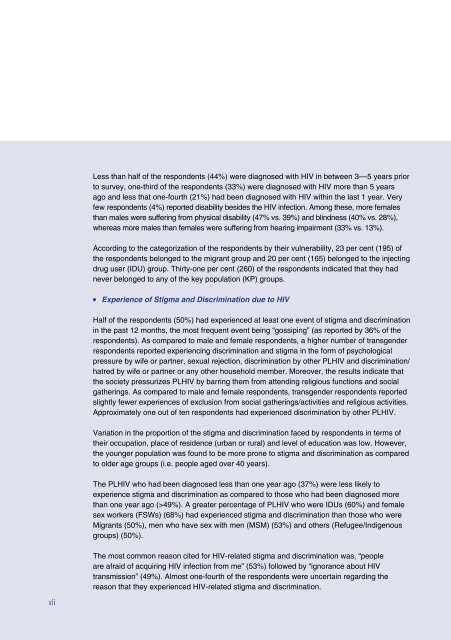PLHIV Stigma Index in Nepal
PLHIV Stigma Index in Nepal
PLHIV Stigma Index in Nepal
- No tags were found...
Create successful ePaper yourself
Turn your PDF publications into a flip-book with our unique Google optimized e-Paper software.
Less than half of the respondents (44%) were diagnosed with HIV <strong>in</strong> between 3—5 years priorto survey, one-third of the respondents (33%) were diagnosed with HIV more than 5 yearsago and less that one-fourth (21%) had been diagnosed with HIV with<strong>in</strong> the last 1 year. Veryfew respondents (4%) reported disability besides the HIV <strong>in</strong>fection. Among these, more femalesthan males were suffer<strong>in</strong>g from physical disability (47% vs. 39%) and bl<strong>in</strong>dness (40% vs. 28%),whereas more males than females were suffer<strong>in</strong>g from hear<strong>in</strong>g impairment (33% vs. 13%).Accord<strong>in</strong>g to the categorization of the respondents by their vulnerability, 23 per cent (195) ofthe respondents belonged to the migrant group and 20 per cent (165) belonged to the <strong>in</strong>ject<strong>in</strong>gdrug user (IDU) group. Thirty-one per cent (260) of the respondents <strong>in</strong>dicated that they hadnever belonged to any of the key population (KP) groups.nExperience of <strong>Stigma</strong> and Discrim<strong>in</strong>ation due to HIVHalf of the respondents (50%) had experienced at least one event of stigma and discrim<strong>in</strong>ation<strong>in</strong> the past 12 months, the most frequent event be<strong>in</strong>g “gossip<strong>in</strong>g” (as reported by 36% of therespondents). As compared to male and female respondents, a higher number of transgenderrespondents reported experienc<strong>in</strong>g discrim<strong>in</strong>ation and stigma <strong>in</strong> the form of psychologicalpressure by wife or partner, sexual rejection, discrim<strong>in</strong>ation by other <strong>PLHIV</strong> and discrim<strong>in</strong>ation/hatred by wife or partner or any other household member. Moreover, the results <strong>in</strong>dicate thatthe society pressurizes <strong>PLHIV</strong> by barr<strong>in</strong>g them from attend<strong>in</strong>g religious functions and socialgather<strong>in</strong>gs. As compared to male and female respondents, transgender respondents reportedslightly fewer experiences of exclusion from social gather<strong>in</strong>gs/activities and religious activities.Approximately one out of ten respondents had experienced discrim<strong>in</strong>ation by other <strong>PLHIV</strong>.Variation <strong>in</strong> the proportion of the stigma and discrim<strong>in</strong>ation faced by respondents <strong>in</strong> terms oftheir occupation, place of residence (urban or rural) and level of education was low. However,the younger population was found to be more prone to stigma and discrim<strong>in</strong>ation as comparedto older age groups (i.e. people aged over 40 years).The <strong>PLHIV</strong> who had been diagnosed less than one year ago (37%) were less likely toexperience stigma and discrim<strong>in</strong>ation as compared to those who had been diagnosed morethan one year ago (>49%). A greater percentage of <strong>PLHIV</strong> who were IDUs (60%) and femalesex workers (FSWs) (68%) had experienced stigma and discrim<strong>in</strong>ation than those who wereMigrants (50%), men who have sex with men (MSM) (53%) and others (Refugee/Indigenousgroups) (50%).Approximately one-third of the respondents who were compelled to change their place ofaccommodation or were denied rental accommodations and those who were reportedlyrefused employment dur<strong>in</strong>g the 12 months prior to the survey said that this was due to theirHIV status. The study found that discrim<strong>in</strong>ation of <strong>PLHIV</strong> at educational <strong>in</strong>stitutions was low,with only 2.2% of the <strong>PLHIV</strong> and 2.6% of the children of <strong>PLHIV</strong> be<strong>in</strong>g dismissed, suspendedor prevented from attend<strong>in</strong>g any educational <strong>in</strong>stitution.The results of the study <strong>in</strong>dicated that health personnel were somewhat <strong>in</strong>volved <strong>in</strong>discrim<strong>in</strong>at<strong>in</strong>g aga<strong>in</strong>st and stigmatiz<strong>in</strong>g <strong>PLHIV</strong>. Respondents reported <strong>in</strong>stances of denial ofhealth services <strong>in</strong>clud<strong>in</strong>g dental care (7%) and denial of family plann<strong>in</strong>g services (3%) andsexual and reproductive health services (2%) by health workers. A few respondents believedthat their medical/health records were not kept confidential.nSelf-stigmaApproximately n<strong>in</strong>e out of ten respondents (87%) had experienced at least one feel<strong>in</strong>g ofself-stigma, such as shame, guilt, blam<strong>in</strong>g others, low self-esteem, suicidal thoughts andwill<strong>in</strong>gness to be punished. The feel<strong>in</strong>gs of self-stigma were slightly lower among female(81%) than male (92%) and transgender (100%) respondents. Moreover, it was found thatself-stigma was high among residents of both urban (90%) and rural (87%) areas. Similarly,the results <strong>in</strong>dicated that such feel<strong>in</strong>gs were more common among young respondents whowere below the age of 25 years (98%) than those belong<strong>in</strong>g to older age groups.Most of the transgender respondents (93%) and male (87%) respondents blamed themselvesfor becom<strong>in</strong>g <strong>in</strong>fected, whereas a large number of female respondents (57%) blamed othersfor acquir<strong>in</strong>g the <strong>in</strong>fection. Guilt, shame and low self-esteem were the most prevalent feel<strong>in</strong>gsamong transgender and male respondents. Furthermore, a larger percentage of transgenderrespondents (56%) experienced suicidal feel<strong>in</strong>gs, as compared to female (17%) and male(11%) respondents.Self-stigma had also led respondents to adopt various measures, such as “not hav<strong>in</strong>gadditional children” (males: 60%, females: 62% and transgender people: 52%), “notgett<strong>in</strong>g married” (males: 30%, females: 47%, and transgender people: 77%), “becom<strong>in</strong>gcelibate” (males: 7%, females: 35%, transgender people: 7%) and “stopp<strong>in</strong>g to attend socialgather<strong>in</strong>gs” (13% of the respondents). One out of 10 or 11 per cent of the respondentsdecided not to visit local cl<strong>in</strong>ics and 7 per cent decided not to visit hospitals when they neededtreatment.The most common reason cited for HIV-related stigma and discrim<strong>in</strong>ation was, “peopleare afraid of acquir<strong>in</strong>g HIV <strong>in</strong>fection from me” (53%) followed by “ignorance about HIVtransmission” (49%). Almost one-fourth of the respondents were uncerta<strong>in</strong> regard<strong>in</strong>g thereason that they experienced HIV-related stigma and discrim<strong>in</strong>ation.n Rights, laws and policiesThe stigma <strong>in</strong>dex referred to an <strong>in</strong>ternational agreement of 2001 called “Declaration ofCommitment on HIV/AIDS.” A quarter of the respondents (26%) had heard of this declaration8vii9viii
















